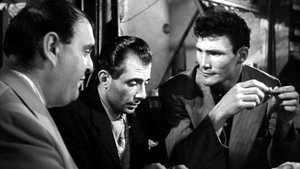Contact: [email protected]
Video Sources 0 Views
- Watch trailer
- Panic in the Streets


Synopsis
Table of Contents
ToggleReview: Panic in the Streets (1950) – A Tense Thriller with a Social Conscience

Introduction
Panic in the Streets, released in 1950, is a gripping thriller that not only delivers edge-of-your-seat suspense but also explores societal issues such as public health and law enforcement. Directed by Elia Kazan, this film noir stands as a testament to the power of cinema to entertain and provoke thought simultaneously. In this review, we will delve into the tension and significance of Panic in the Streets and its enduring relevance.
Check The Full Colorized Movies List
Check Our Colorized Movies Trailer Channel
Understanding Panic in the Streets (1950): Director, Cast, and Genre
Directed by Elia Kazan, Panic in the Streets features a talented ensemble cast including Richard Widmark as Lieutenant Commander Clint Reed, Paul Douglas as Captain Tom Warren, and Barbara Bel Geddes as Nancy Reed. The film falls within the genre of crime thriller, characterized by its suspenseful storytelling and morally complex characters.
Exploring the World of Panic in the Streets (1950): Plot and Characters
Set in the bustling streets of New Orleans, Panic in the Streets follows the race against time to stop the spread of a deadly pneumonic plague. When a murdered criminal carrying the virus is discovered, health officials and law enforcement must work together to locate and quarantine those who may have been exposed. As tensions rise and the clock ticks down, the film delivers heart-pounding suspense while also examining themes of duty, sacrifice, and the value of human life.
The Art of Film Colorization
While Panic in the Streets was originally filmed in black and white, its early colorized version adds a new layer of visual richness and depth to its atmospheric cinematography. The colorization process enhances the film’s evocative imagery and captures the vibrant energy of its New Orleans setting with stunning clarity.
Early Colored Films: A Brief History
The history of early colored films is marked by innovation and experimentation as filmmakers sought to enhance the visual appeal of their movies. From hand-tinted frames to pioneering technicolor processes, the evolution of colorization techniques transformed the cinematic landscape, offering audiences a new way to experience classic stories and thrilling dramas.
Panic in the Streets (1950) and Its Early Colored Version
The decision to release Panic in the Streets in a colorized format was made with the intention of immersing audiences in the vibrant energy of its New Orleans setting and enhancing the film’s visual impact. While some purists may prefer the original black and white version, the early colorized edition of Panic in the Streets adds a new dimension to its atmospheric cinematography and captures the vibrant energy of its New Orleans setting with breathtaking clarity.
The Debate Over Film Colorization
The debate over film colorization continues to divide audiences and industry professionals alike. While some argue that colorization breathes new life into classic films and makes them more accessible to modern audiences, others maintain that it compromises the artistic integrity of the original work. As technology advances and filmmaking techniques evolve, the debate over colorization remains a topic of ongoing discussion within the film community.
Examining Panic in the Streets (1950) as an Early Colored Film
Viewing Panic in the Streets in its early colorized iteration offers audiences a fresh perspective on its atmospheric beauty and vibrant setting. The colorization process enhances the film’s evocative cinematography and captures the vibrant energy of its New Orleans setting with stunning clarity. As viewers are drawn into the heart-pounding race against time, they are treated to a visual feast that immerses them in the thrilling drama of the story.
Influence and Legacy: Panic in the Streets (1950)’s Impact on Cinema
Panic in the Streets is widely regarded as a classic example of the crime thriller genre that continues to captivate audiences with its heart-pounding suspense and socially conscious storytelling. Its examination of public health crises and the challenges of law enforcement remains relevant in today’s world, making it a timeless classic that continues to resonate with audiences around the world.
Director’s Cinematic Legacy: Beyond Panic in the Streets (1950)
Elia Kazan’s directorial legacy extends far beyond Panic in the Streets, encompassing a diverse body of work that includes acclaimed films such as On the Waterfront and A Streetcar Named Desire. As one of the most respected filmmakers of his generation, Kazan was known for his keen insight into human nature and his ability to tackle complex social issues with intelligence and nuance. Panic in the Streets stands as a testament to his talent and vision, solidifying his reputation as one of the great auteurs of classic American cinema.
Themes Explored in Panic in the Streets (1950)
At its core, Panic in the Streets explores themes of duty, sacrifice, and the value of human life in the face of a public health crisis. Through its gripping storyline and morally complex characters, the film challenges viewers to confront uncomfortable truths about society’s response to emergencies and the importance of cooperation and compassion in times of crisis.
Reception and Controversy Surrounding Panic in the Streets (1950)
Upon its release, Panic in the Streets received widespread critical acclaim for its gripping storyline, tense atmosphere, and socially conscious themes. While the decision to release the film in a colorized format sparked debate among purists, its enduring popularity has cemented its status as a timeless classic of American cinema.
Where to Watch Panic in the Streets (1950) Online
For those eager to experience Panic in the Streets for themselves, the film is readily available on popular streaming platforms such as Amazon Prime Video, Google Play Movies, and iTunes. Whether viewed in its original black and white format or its early colorized iteration, Panic in the Streets offers a cinematic experience that is both thrilling and thought-provoking.
FAQs About Panic in the Streets (1950)
1. Is Panic in the Streets based on a true story?
No, Panic in the Streets is a fictional film that explores themes of public health crises and law enforcement in a suspenseful thriller format. While the film’s storyline may draw inspiration from real-life events and societal issues, its characters and plot are works of fiction.
2. Who starred in Panic in the Streets?
Panic in the Streets stars Richard Widmark as Lieutenant Commander Clint Reed, Paul Douglas as Captain Tom Warren, and Barbara Bel Geddes as Nancy Reed. Their powerful performances bring depth and authenticity to the film’s gripping storyline, capturing the urgency and tension of the race against time.
3. What is the central message of Panic in the Streets?
At its core, Panic in the Streets explores themes of duty, sacrifice, and the value of human life in the face of a public health crisis. Through its gripping storyline and morally complex characters, the film challenges viewers to confront uncomfortable truths about society’s response to emergencies and the importance of cooperation and compassion in times of crisis.
4. Why was Panic in the Streets released in a colorized format?
The decision to release Panic in the Streets in a colorized format was made with the intention of immersing audiences in the vibrant energy of its New Orleans setting and enhancing the film’s visual impact. While some purists may prefer the original black and white version, the early colorized edition of Panic in the Streets adds a new dimension to its atmospheric cinematography and captures the vibrant energy of its setting with breathtaking clarity.
5. What is the legacy of Panic in the Streets?
Panic in the Streets is widely regarded as a classic example of the crime thriller genre that continues to captivate audiences with its heart-pounding suspense and socially conscious storytelling. Its examination of public health crises and the challenges of law enforcement remains relevant in today’s world, making it a timeless classic that continues to resonate with audiences around the world.
6. Are there any sequels or remakes of Panic in the Streets?
No, there have been no official sequels or remakes of Panic in the Streets. However, the film’s enduring popularity has inspired countless reinterpretations and adaptations in various media. Nonetheless, none have captured the heart-pounding suspense and socially conscious themes of the original 1950 classic.
7. Where can I watch Panic in the Streets online?
For those eager to experience Panic in the Streets for themselves, the film is readily available on popular streaming platforms such as Amazon Prime Video, Google Play Movies, and iTunes. Whether viewed in its original black and white format or its early colorized iteration, Panic in the Streets offers a cinematic experience that is both thrilling and thought-provoking.
Conclusion
In conclusion, Panic in the Streets (1950) stands as a gripping thriller that not only delivers edge-of-your-seat suspense but also explores societal issues such as public health and law enforcement. Whether viewed in its original black and white format or its early colorized iteration, Elia Kazan’s visionary direction and the powerful performances of the cast offer a cinematic experience that is both thrilling and thought-provoking. As audiences grapple with the enduring relevance of its themes, Panic in the Streets remains a timeless classic that continues to captivate viewers with its tension and significance.



















